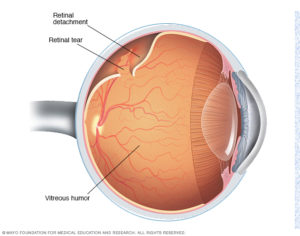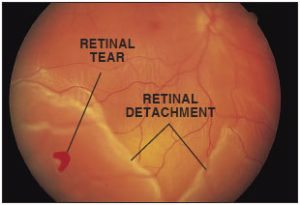Is a Retinal Detachment Serious? The Answer is YES!
A retinal detachment is a very serious problem that will almost always lead to blindness if not treated.
 The retina is the sensory tissue that lines the back wall of the eye. It can be described as the wallpaper of the back of your eye. A retinal detachment occurs when the retina is separated from the inside of your eye and can no longer transmit images properly through the optic nerve to the brain. If the center of the retina, the macula, is involved in the detachment, the vision is extremely blurred. If the macula is not involved in the area of detachment, there may be some loss of peripheral vision corresponding to the part of the retina that is detached.
The retina is the sensory tissue that lines the back wall of the eye. It can be described as the wallpaper of the back of your eye. A retinal detachment occurs when the retina is separated from the inside of your eye and can no longer transmit images properly through the optic nerve to the brain. If the center of the retina, the macula, is involved in the detachment, the vision is extremely blurred. If the macula is not involved in the area of detachment, there may be some loss of peripheral vision corresponding to the part of the retina that is detached.
What Causes a Retinal Detachment?
The center of the eye is filled with a clear gel called the vitreous. As we get older, the vitreous begins to degenerate into a liquid and this causes it to pull away from the surface of the retina. This process, called a posterior vitreous detachment, usually occurs without damaging the retina. In some cases, the vitreous may pull hard enough to tear the retina in one or more places. As time passes, fluid from the center of the eye will pass through the tear and begin accumulating beneath the retina, causing a retinal detachment. There are some conditions that increase the likelihood of developing a retinal detachment.
These include:
- Prior eye surgery, such as cataract removal
- Traumatic injury
- History of retinal detachment in either eye
- Family history of retinal detachment
The doctors at Raleigh Ophthalmology recognize that evaluation and treatment are only the first steps on the road to recovery. The patient’s active participation and cooperation are also important in achieving long-term, positive results.
 A retinal detachment is commonly preceded by a posterior vitreous detachment which gives rise to these symptoms:
A retinal detachment is commonly preceded by a posterior vitreous detachment which gives rise to these symptoms:
- flashes of light (photopsia) – very brief in the extreme peripheral (outside of center) part of vision
- a sudden dramatic increase in the number of floaters
- a ring of floaters or hairs just to the temporal side of the central vision
- a slight feeling of heaviness in the eye
Although most posterior vitreous detachments do not progress to retinal detachments, those that do produce the following symptoms:
- a dense shadow that starts in the peripheral vision and slowly progresses towards the central vision
- the impression that a veil or curtain was drawn over the field of vision
- straight lines that suddenly appear curved
- central visual loss
